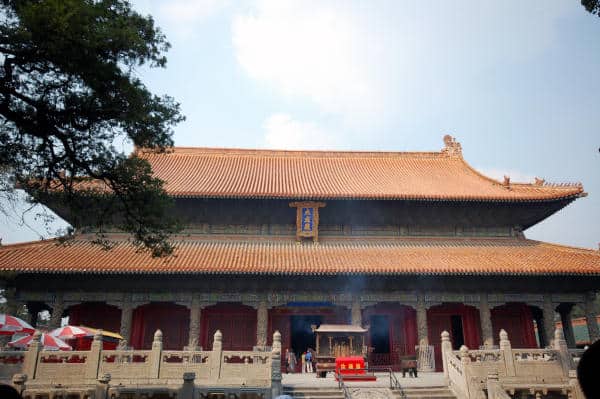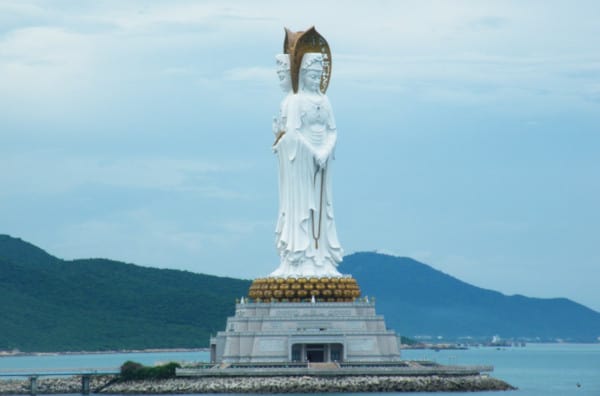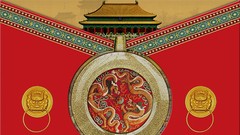China is certainly the home of so many ancient temples from Buddhism, Confucianism, Taoism, and various other spiritual traditions.
Many of these temples have stood for hundreds and even thousands of years. So, when you are stepping on one of these Chinese temples, you are essentially traveling back in time.
Here, we will discuss five of the most amazing temples in China which are must-visit if you want to lose yourself in centuries of history.
1. Temple of Heaven (Beijing)

The Temple of Heaven, located in southern Beijing, is one of the most famous tourist sites in China, and at four times the size of the famous Forbidden City, there’s a lot to see.
The Temple of Heaven is widely accepted as a Taoist temple nowadays. However, it is mainly used for the Chinese Heaven Worship ritual, which is actually much older than Taoism itself.
History recorded that the emperor Zhu Yuanzhang (朱璋), the first emperor of the Ming dynasty, was the one who built this temple in 1447 on the southeast of the Forbidden City.
Back then, the temple was known as the Temple of Heaven and Earth, and the emperor and the ones after him are observing the tradition of sacrificing to both heaven and earth in the same temple.
Only later on in the 16th century that the Jiajing emperor (皇帝) broke it into four temples: Temple of Heaven, Temple of Earth, Temple of Sun, and Temple of Moon.
A large-scale renovation was performed during the time of the Qing dynasty (1736-1795), and the temple suffered great damages from wars in 1900 and the following civil wars.
Various renovations were performed to preserve the Temple of Heaven since then, and now it serves as both a public park and a historical site.
Important Places to Visit in the Temple of Heaven
- The Chinese Rose Garden
A very beautiful rose garden especially during May when the roses blossoms. Also, just next door is the 100-flower garden.
- The Hall of Prayer for Good Harvest
The main structure of the temple, and the area where past emperors pray and sacrifice to heaven. Also, the tallest structure of the Temple, standing 38 meters high. A must-see.
- Fasting Palace
This palace was where past emperors would stay before rituals in the temple. Security is tighter in this area, and entrance into the Palace would require an ID card or passport.
Mesmerizing architecture and a must-visit if you want to experience history.
Related reading: “Top 5 Amazing Natural Places in China“
2.Qufu Confucius Temple

The Qufu Confucius Temple is located inside the south gate of Qufu, Shandong province, and is actually one of the three largest architectural complexes in China (together with the Summer Palace in Beijing and the Mountain Resort of Chengde).
History said that the Temple started as modest three houses in 478 BC, two years after the death of Confucius, and was expanded throughout the years.
During the time of the Ming dynasty (1368-1644) and Qing (1644-1911), the temple was rebuilt and renovated into the shape we have today.
The Temple is divided into nine different courtyards with three halls, one altar, one pavilion, and three temples. In total, there are 54 gateways and 466 rooms covering an area of 2,346,609 sq ft or 218,000 square meters.
Since 1994, the Temple of Confucius has been part of the UNESCO World Heritage List.
Important Places to Visit in Qufu Confucius Temple
- Jinsheng Yuzhen Archway (金玉振坊)
The stone archway in front of the Temple is named after the two praises by Mencius for the sage Confucius: 金 (golden sound) and 玉振 (jade vibration).
- Kuiwen Pavilion (奎)
Built in 1018, the towering pavilion is 23.35 meters tall and is famous for being an impregnable wood architecture. In front of the Kuiwen pavilion are two other pavilions of four imperial tablets from the Ming dynasty.
- Thirteen Stele Pavilions (三碑亭)
There are 55 tablets of emperors in these pavilions ranging from the time of the Tang Dynasty (618-907) to the Republic era (1912-1949).
These tablets document the long renovation history of the temple and the reverence for Confucius by various emperors.
Related reading: “Top 5 Famous Monuments in China“
3. Hanging Monastery

Hanging Monastery stands at the foot of Mt. Hengshan, around 3 miles (3 km) south of Hunyuan County and around 40 miles (65 km) from Datong City.
The Hengshan Hanging Temple was built in 491 CE, and so has survived more than 1,500 years. However, the monastery experienced major rebuilds during the time of the Ming Dynasty (1368-1644) and the Qing Dynasty (1644-1911).
The most interesting quality of the Hanging Monastery is how it is affixed to the side of a cliff, 75 meters off the ground.
So, it is widely regarded as an architectural masterpiece not only in China but all over the world. Seen from below, the Monastery seems like a tumble-down castle in the air.
So, the Hanging Monastery is an interesting attraction, a mixture of aesthetics, mechanical wonders, and spiritualism.
Also, Hanging Monastery includes Buddhism, Confucianism, and Taoism inside the same temple. There are sculptures of Confucius, Lao Tzu, and Sakyamuni inside the monastery appearing together, which is very unusual.
There are over 80 sculptures in total made of copper, iron, stone, and terracotta in over 40 halls and cabinets.
Not one, but two different steles more than 800 years old are on the monastery, and the inscription on these steles describe the different backgrounds of the three founders of the Hanging Monastery and praises them for their respective contributions.
Hanging Monastery has always been a popular tourist destination since ancient times, and if you appreciate architecture and construction, this is a must-visit site.
Related reading: “How To Travel in China Without Speaking Chinese?“
4. Nanshan Temple

Nanshan Temple on the Island of Hainan is the largest Buddhist temple built in China since the founding of the People’s Republic of China in 1949.
The key highlight of the temple is the 108-meter high, gleaming white Guan Yin (Avalokitesvara) sculpture, which is bigger than the Statue of Liberty.
The statue is built onto a rocky outcropping in the South Sea of Sanya, and the entire temple grounds are built to complement this massive sculpture.
The Nanshan Temple was built in 1988 and was completed pretty recently in April 1998 to commemorate the 2,000th anniversary of the influence of Buddhism in China.
The island of Hainan itself is widely considered an important place for Buddhism in China and is considered to be a holy devotion to Guanyin (Avalokitesvara).
Guanyin is considered an incarnation of Buddha in some traditions or a Boddhisattva in others and is a very influential figure in China’s Buddhism.
🧧 Use our free “ChinaGoGuide” app. Your personal guide to your journey to China. Try it now!
Important Places to Visit in Nanshan Temple
- The Dharma-Door of Nonduality
It is believed that there are 84,000 Dharma-Door to reach perfection in Buddhism, and among those, the Nonduality door is considered the highest level.
Even if you are not a Buddhist, you’ll appreciate the aesthetics of this Dharma Door, which is distinctive from most structures in the temple, modeled after the architectural style of the Southern-Northern Dynasty (420-589).
- Gold and Jade Statue of Guanyin
The statue of Guanyin (Avalokitesvara) is enshrined at a hall in the Nanshan temple and is famous for being covered with over 221 lbs (100 kg) of gold and 120 carats of South African diamond and countless jewels.
- Sea-watch terrace
A terrace facing the South China Sea, just in front of the temple. You can admire the spectacular 108-meter-high Guanyin statue, the vast seascape of China, and the overall architecture of the Nanshan Temple.
Related reading: 23 Stunning Statues in China You Should Plan to Explore – Opens in new tab
5. Longmen Cave Temples

The Longmen Cave Temples (or Longmen Grottoes) are 2,300 cave temples that are individually carved into nearly a mile-long of limestone cliffs. So, it is another architectural wonder.
The caves now are home to various Chinese arts from various periods, especially from the time of the Northern Wei and Tang Dynasties (316-907).
In total, there are a whopping 110,000 statues, 60 stupas, and 2,800 inscriptions in these caves. Also, the statues and Buddhas are carved directly out of the limestones that formed the hillside.
The oldest grotto carved in this Cave Temples complex is the Guyang Cave, which contains over 800 inscriptions and 1,000 niches.
It houses the central statues of Sakyamuni Buddha and two Bodhisattvas, and are reflections of the late Northern Wei style of sculpting and calligraphy.
Since 2000 the Longmen Caves or Longmen Grottoes have been part of the UNESCO World Heritage List as “an outstanding manifestation of human artistic creativity”.
Important Places to Visit in Longmen Cave Temples
- Fengxian Temple
Build during the time of the Tang Dynasty, and is the largest cave in the Longmen Cave Temples.
About 118 feet wide and 136 feet long, the most impressive statue in this grotto is the Vairocana Buddha sculpture, sitting cross-legged on an eight-square lotus throne.
There are nine major statues in this grotto that were built according to the Buddhist rite.
- Wanfo Cave
Completed in 680 CE, the Wanfo cave is a typical grotto of the Tang Dynasty with two rooms and flat roofs.
It got its name from the 15,000 small Buddha statues, which are chiseled in the southern and northern walls of the cave.
The main statue of this temple is the Buddha Amida sitting on the lotus Sumeru throne, with 54 lotuses carved on the wall behind the Amida statue, upon which are 54 Bodhisattvas statues in different shapes and expressions.
Related reading: “Top 5 Famous Historic Buildings in China“
Online Courses about Chinese Culture from Udemy (Aff.link)

Stay in Touch
 Join our newsletter by using the forms on this website or click here!
Join our newsletter by using the forms on this website or click here! Follow us on Google News
Follow us on Google News Follow us on Facebook
Follow us on Facebook
Featured Photo from Wikimedia (CC BY-SA 3.0)





